Growing hope, sowing light
By Lulah Ellender
Last week I was walking with friends along the edge of a flooded field, the ground brown and swampy. In this watery barrenness we spotted one lone marigold. Burnt orange, chunky, defiant. It felt like a symbol of hope in an otherwise bleak landscape.
These signs are all around us – in our gardens, windowsill pots, local parks and cracked pavements. The determined green spears pressing through frosty earth. Tiny buds on trees, waiting to unfurl as the light returns. Summer roses turning to glossy hips that bejewel the hedgerows. The abundance of an autumn harvest, carrying armfuls of nourishment and flavour to the table.
Gardens begin in our imagination, a memory of childhood freedom, smells and colours. Slowly, over a lifetime, in different places and different ways, we plant that imaginary place and conjure a living picture out of our dreams. Yesterday I planted tulips, far too late. Yet as I buried the papery bulbs I was full of hope that their bright blooms will emerge in a few months’ time. Poet Emily Dickinson wrote, ‘I am out with lanters/ Looking for myself’ – these are my lanterns, the plants that endure despite neglect, drought, frost and lateness.
Plants show us that hope is not just the thing with feathers. It is the thing with roots that burrow deep into winter’s soil, turning chemicals and compounds into blazing beauty. It is my long-gone mother’s primroses I dug up from her garden and planted in mine, before her house was sold. It is the self-seeded love-in-a-mist that carpets our front garden, becoming even more beautiful as it decays. Each season contains the next, and the next. There is a motion that keeps hope afloat.
Sometimes we find places that confound our preconceptions of how things grow and where to find beauty. Like Prospect Cottage in Dungeness, created by artist and activist Derek Jarman. Crammed with lavenders, sea kale, poppies, valerian and santolina, it’s a borderless, defiant yet tender place, nurtured with love and fury in a shingle desert.
When Russia began its fullscale invasion of Ukraine in February 2022, people around the world started growing sunflowers as a symbol of support for Ukraine. The unofficial national flower represents peace but also resistance, and this response is part of a long tradition of planting beauty amid conflict and adversity. We saw footage of a woman urging a Russian soldier to 'Take these seeds so sunflowers grow here when you die'. There are images of flowers painted around bullet holes in a fence. And a woman planted flowers in Kyiv's public spaces in anticipation of the end of the conflict, creating new life amid the horrors of war. She said, 'War is war, but flowers still need to be planted'.
Look back and you’ll find other examples of planting as an act of defiance and faith. Soldiers made gardens in the trenches of the Western Front in WW1 that represented hope and home, and gave them some sense of control amidst the hellish chaos. At the same time, British internees at Ruhlebehn camp in Germany – starving, thousands of miles from home – formed a horticultural society and wrote to the RHS in Britain to request seeds. They created beautiful gardens, growing vegetables to eat and flowers to brighten up their grim surroundings.
In the 1970s Wangari Maathai began planting trees across Kenya as an act of political protest. Her Green Belt Movement gave women the power to protest against human rights abuses, corruption and land exploitation. Later, a Community Gardening Association was created in the wake of the Yugoslavia conflict to make gardens in Sarajevo. The city had been destroyed and was the scene of appalling violence, but these gardens brought communities together.
Ron Finley, known as the Gangster Gardener, has planted an edible forest on sidewalks in his Los Angeles neighbourhood, a place he describes a 'food desert'. Filmmaker Lalage Snow found a beautiful garden in a Kabul army camp, and met a poor man aged 105 growing beans, okra and potatoes at an army checkpoint. The Lemon Tree Trust works with Syrian refugees in Kurdistan, and camp garden organiser Aveen Ismail said, 'Creating a garden was a way for us to heal and remind us of home'.
There is so much power and hope in these gardens. They are not about recreating some imagined paradise, but a show of faith in a better future. This instinct and urge to create beauty in adversity comes from a need for agency where people may be feeling powerless. Writer and psychologist Sue Stuart-Smith calls it 'urgent biophilia' – growing and sowing as a response to trauma. Planting flowers and tending a garden is a way to make something familiar, something enduring and surviving. Gardens remind us of the past and allow us to dream of the future.
Growing requires patience and resilience. Things die, they get eaten by slugs, they don’t show up at all. Yet gardeners carry on, trusting that there’s always next year. We have an opportunity to try again, for rebirth and reinvention, season after season. Just like hope, gardens may be confined by boundaries and walls but they can’t be contained.
[Lulah Ellender is the author of Grounding: Finding home in a garden, published by Granta.]



